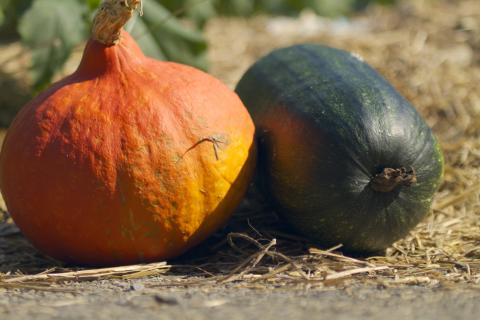October Gardening Tips

Prevent fungal disease issues next year on trees and shrubs by thoroughly raking up all fallen leaves and disposing of them. Common diseases, like maple anthracnose and apple scab, overwinter in diseased fallen leaves. In the spring, these fungi release spores into the air, which are carried by the wind to developing leaves, flowers, fruit, or young twigs. Removing fallen leaves reduces the amount of fungus in the environment that can infect trees the following year. Infected leaves can be burned, buried, or composted at a municipal site. Another option is to chop leaves with a mulching lawn mower and apply a fall lawn fertilizer, which will help breakdown leaves and give the grass a boost.
Do not add diseased foliage to the compost pile unless you are sure it will get hot enough (140℉) to kill the pathogen. Composting is often broken down into two separate categories, cold and hot. The easiest method, cold composting, requires little maintenance and simply involves piling materials on the ground or in a bin and letting them sit until they break down. This method can take as long as a year or more for the compost to be finished, which is fine for many gardeners. The piles do not usually get hot enough to kill plant pathogens, so diseased plant material should be kept out. Hot composting is labor intensive, but it yields finished compost in a relatively short period of time. It requires a large amount of organic material for piles to reach a height and width of at least 4-5 feet, and the piles must be kept moist and well aerated with frequent turnings. Well-executed hot compost piles can reach over 140℉, which is hot enough to kill most weed seeds and plant diseases.
Though cutting everything to the ground may give the garden a tidy look, it does a disservice to wildlife species that can make use of some plants in the winter. Leaving perennial seed heads provides natural foraging habitat for native wildlife. In the winter months when food is scarce, gardens full of withered fruit and dried seed heads can provide birds with a reliable food source. Dried stems and leaves can also provide important overwintering habitat for beneficial insects. Cut back perennials that are diseased but leave healthy seed heads standing. All perennials left standing for the winter should be cut to the ground in the spring before new growth starts.
Dig and save tender tubers and bulbs such as dahlias, cannas, and gladiolus. Wash the soil from the bulbs or tubers and let them dry for a few days out of direct sunlight. Pack them in moistened peat moss, vermiculite, wood shavings or shredded newspaper. A little moisture goes a long way. If the storage medium is too wet, the tubers will likely rot. Store the tubers in a cool place until spring (below 50℉ but above freezing). Remember to occasionally check on the tubers over the winter. Remove any that have started to rot before the decay spreads to healthy ones.
Wait to plant spring-blooming bulbs until the soil temperature drops below 60°F, which can be measured with a soil thermometer. If bulbs are planted when temperatures are warm, they may come up too soon and their foliage may be susceptible to winter damage. Ideally, bulbs need a little time to establish their root systems before the winter, so aim to have them in the ground at least a few weeks before the ground freezes. In New Hampshire, this likely means waiting until the latter half of October or early November, keeping in mind that the soil near sunny foundations will cool down much slower than that in low-lying or shady areas.
Bring houseplants back indoors before a hard frost. Carefully check for insect and disease issues before hauling plants inside. Pests like aphids and spider mites can usually be removed by spraying plants with a steady stream of water. Scale insects can be gently scraped off stems and leaves, or gently rubbed away with a cotton swab dipped in rubbing alcohol. Pesticides like neem or insecticidal soap should be used as a last resort, and always according to product labels.
Harvest and store the last vegetables in the garden. Root crops can be left in the ground almost up until the soil freezes and will develop a sweeter flavor after cold exposure. Winter squash should be harvested before frost and when their skins are hard enough to resist puncture from a fingernail. Carrots and potatoes can be kept for several months if they are handled carefully and kept in a cool and humid place. Onions, pumpkins and squash can last two to six months depending on variety, and if they are stored in cool and dry conditions.
Do you love learning about stuff like this?
SUBSCRIBE TO GRANITE STATE GARDENING
A monthly newsletter for New Hampshire gardeners, homesteaders and plant-lovers of all kinds, that includes seasonal suggested gardening tips, upcoming events and articles with proven solutions for your garden and landscape.
Got questions? The Ask UNH Extension Infoline offers practical help finding answers for your home, yard, and garden questions. Call toll free at 1-877-398-4769, Monday to Friday, 9 a.m. to 2 p.m., or e-mail us at answers@unh.edu.
